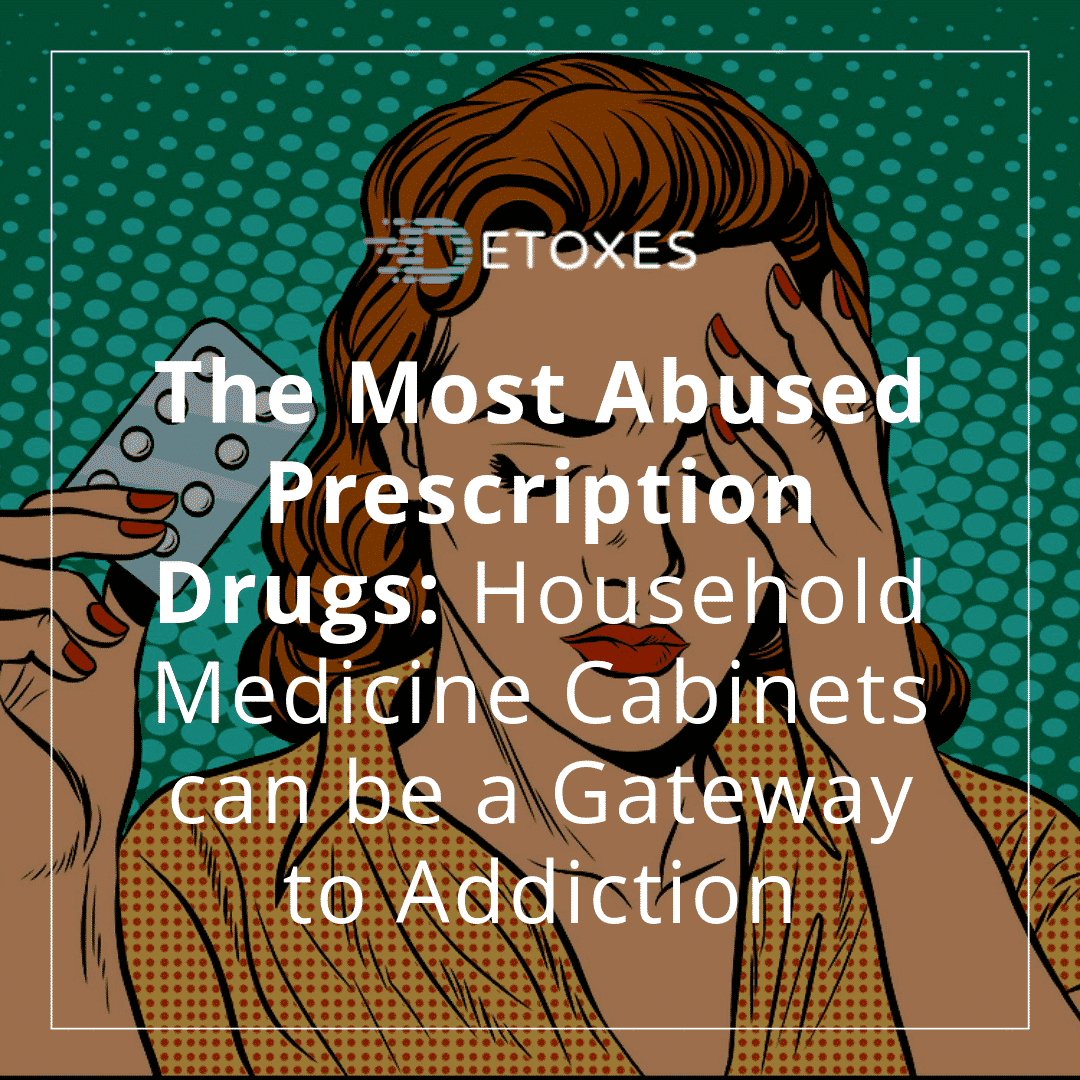Prescription Drugs Abuse: Household Medicine Cabinets can be a Gateway to Addiction
Article Contents
In recent years, prescription drugs have brought the dangers of addiction and overdose closer to home than most Americans probably realize. According to the Substance Abuse and Mental Health Services Administration, the most commonly abused drugs in the United States, after marijuana, are prescribed medications7. In 2017, an estimated 18 million Americans (aged 12 and older) reported taking prescription drugs for nonmedical reasons at least once1.
The purpose may have ranged from getting high, losing weight, or improving focus. Regardless of the reason that prescription drugs are taken illicitly, users face the same risks associated with illegal “street” drugs: addiction and overdose.
What Does this Mean?
There’s an alarming corollary to this increase in prescription drug abuse; namely, an increase in accidental overdoses. This is demonstrated by the number of deaths involving prescription opioids plus synthetic narcotics, which has been increasing steadily since 2014, primarily driven by the use of fentanyl6.
The most common classes of prescription drugs responsible for this recent misuse epidemic are opioids, CNS depressants, and stimulants5.
Opioids and Prescription Drugs Abuse
Opioids are commonly prescribed. They are used to treat severe and chronic pain. When used as directed, they are extremely effective painkillers. Opioid prescriptions have been on the rise since the 1990s as doctors confront the aging population of Baby Boomers3.
When abused, however, recreational and long-term use of opioids poses several risks; akin to illegal opioids like heroin. They have a high potential for addiction and accidental overdose. Furthermore, when combined with CNS depressants, such as alcohol, the depressive effect on the body is enhanced, and coma or death may result5.
Examples of the most abused prescription opioids include2:
- Oxycodone
- Hydrocodone
- Hydromorphone
- Methadone
- Morphine
- Codeine
CNS Depressants and Prescription Drugs Abuse
Depressants (also called tranquilizers, sedatives, and hypnotics) can help treat patients who suffer from insomnia or anxiety5.
For example, Valium and Xanax are two commonly prescribed examples of a class of depressant known as benzodiazepines. This class of drug is thought to depress the central nervous system by enhancing the neurotransmitter known as gamma-aminobutyric acid, or GABA8. When present in the brain or spinal cord, GABA suppresses the activity of nerve cells. An over-active nervous system is thought to cause anxiety and restlessness and thus enhancing GABA provides a relieving, calming effect to those who need it5.
When this prescription drug is abused — especially in combination with alcohol —depressants can cause serious adverse effects such as respiratory depression and/or coma. Unfortunately, once dependent on a drug like Xanax, users often keep using it to avoid withdrawal symptoms of increased anxiety, insomnia, as well as physical symptoms akin to withdrawing from other depressants8.
In addition to benzodiazepines, there are non-benzodiazepine drugs used for insomnia; namely zolpidem, eszopiclone, and zaleplon. With a precursory glance, they appear more attractive due to a shorter duration of action and less daytime sleepiness. They also have less risk of dependence when compared to benzodiazepines. However, hallucinations and psychosis have been reported with the use of these drugs8.
Lastly, barbiturates are a subtype that has been largely replaced by benzodiazepines for anxiety and insomnia. Although withdrawal from benzodiazepines can be unpleasant, it is rarely life-threatening. However, withdrawal from prolonged use of barbiturates can have life-threatening complications. Barbiturates also have a higher overdose potential5.
Most abused examples5:
- Valium (diazepam)
- Xanax (alprazolam)
- Klonopin (clonazepam)
Stimulants and Prescription Drugs Abuse
Prescription stimulants, such as amphetamines like Adderall and Ritalin, are used to treat Attention Deficient Hyperactivity Disorder (ADHD). The increase in alertness and attention helps those diagnosed with ADHD to focus and increase productivity.
Stimulants enhance the effects of monoamine neurotransmitters. This, in turn, increases heart rate and blood sugar as well as opens the pathways of the respiratory system5. As such, stimulants are often misused as a way to get high, boost energy, and/or lose weight. Not only are users at risk of addiction due to the surge in neurotransmitter release, but high doses can also pose a danger to vital organs such as the heart, causing an irregular heartbeat and even cardiac arrest. Acute toxicity can also occur, causing psychosis and hallucinations4.
The most abused examples5:
- Adderall
- Dexedrine
- Ritalin
References
- Center for Behavioral Health Statistics and Quality. (2018). Results from the 2017 National Survey on Drug Use and Health: Detailed Tables. Rockville (MD): SAMHSA.
- Manchikanti, L. (2006). Prescription drug abuse: what is being done to address this new drug epidemic? Testimony before the Subcommittee on Criminal Justice, Drug Policy and Human Resources. Pain Physician; 9:287–321
- McHugh, R. K., Nielsen, S., & Weiss, R. D. (2014). Prescription drug abuse: from epidemiology to public policy. Journal of Substance Abuse Treatment, 48(1), 1-7.
- Morton, A. W., & Stockton, G.G. (2000). Methylphenidate Abuse and Psychiatric Side Effects. Prim Care Companion J Clin Psychiatry, 2(5): 159-164.
- National Institute on Drug Abuse. (2018). Misuse of Prescription Drugs. Retrieved 25 March, 2019 from https://www.drugabuse.gov/publications/misuse-prescription-drugs/what-classes-prescription-drugs-are-commonly-misused.
- National Institute on Drug Abuse. (2019). Overdose Death Rates. Retrieved 25 March, 2019 from https://www.drugabuse.gov/related-topics/trends-statistics/overdose-death-rates.
- Substance Abuse and Mental Health Services Administration. (2013). Results from the 2012 National Survey on Drug Use and Health: Summary of National Findings. Rockville, MD: NSDUH Series H-46, HHS Publication No. (SMA) 13-4795.
- Weaver, M.F. (2015). Prescription Sedative Misuse and Abuse. Yale J Biol Med; 88(3): 247-256




